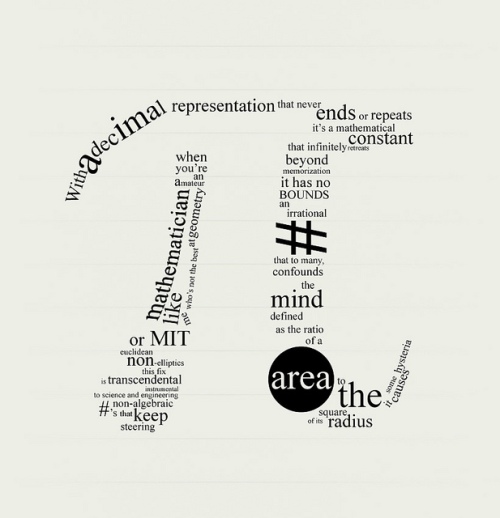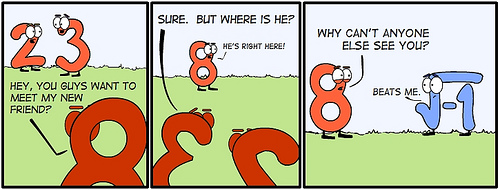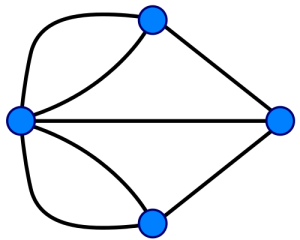There’s far too little geometry—excluding topology and non-Euclidean stuff—on this blog, so let’s add a little.
Our goal is to get to the Euler line, a line that passes through a triangle’s circumcenter, centroid, and orthocenter. The line is only determined for non-equilateral triangles; the points coincide in the equilateral case. We’ll look at the three points above.
The circumcenter, centroid, and orthocenter are all “centers” of triangle. But what is a center of a triangle? Surely, it’s not a point equidistant to all points on the triangle. Our triangle would be a circle in that case.
The circumcenter of a triangle ABC is the center O of the circle K that triangle ABC is inscribed in.
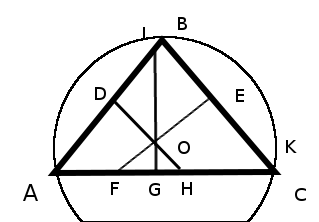
Circumcenter O of triangle ABC. Image drawn by me.
The circumcenter is actually the intersection of the three perpendicular bisectors of the triangle: FE, IG, and DH. To see this, first suppose that triangle ABC has a circumscribed circle K with center O. Draw radii AO, BO, and CO to each of the triangles vertices. This creates three smaller triangles AOB, BOC, and AOC. In each of these smaller triangles, drop an altitude from O. For example, in triangle AOB, altitude OD would be dropped. This splits AOB into two smaller triangles that are congruent by SAS, Line OD is perpendicular to AB by construction, and AD = DB. Hence OD is indeed a perpendicular bisector of side AB. Repeating this for other sides shows that the center of the circumscribed circle is the intersection of ABC‘s perpendicular bisectors.
Moreover, the intersection of any to perpendicular bisectors is equidistant from each of the triangle’s vertices. The reader can see this by considering triangle AOC. Perpendicular bisector IG splits AOC into triangles that are congruent by SAS. It follows that lengths AO and OC are equal. Repeat for the other sides. We then see that the intersection of the perpendicular bisectors is equidistant from the triangle’s vertices. Thus the perpendicular bisectors of a triangle uniquely determine its circumcenter.
The centroid is the intersection of a triangle’s three medians, lines drawn from a vertex that bisect the opposite side. As said in class, the centroid is the center of mass for a thin, triangular solid with uniformly distributed mass.
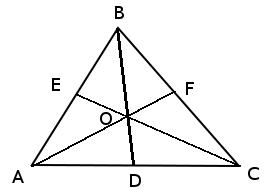
Centroid O of triangle ABC. Drawn by me.
The reader may suspect whether the three medians of a triangle intersect. Clearly two of the medians intersect; otherwise our triangle ABC would be a line. But the full proof is a little tedious. The proof involves assuming that two medians AF and CE intersect and drawing a parallelogram using the midpoints of the medians. We link to some proofs: http://jwilson.coe.uga.edu/EMAT6680Fa06/Chitsonga/MEDIAN/THE%20MEDIANS%20OF%20A%20TRIANGLE.htm uses classical geometry and http://math.stackexchange.com/questions/432143/prove-analytically-the-medians-of-a-triangle-intersect-in-a-trisection-point-of uses vectors.

Four congruent triangles using midpoints. Image drawn by me.
Interestingly, the midpoints of the sides of triangle ABC—the ends of the medians—cut the triangle into four congruent triangles. We will prove this in a roundabout way. Let E be the midpoint of AB. Draw a line EF parallel to AC where F intersects BC. Similarly draw FD parallel to AB. By construction, EFDA and EFCD are parallelograms. Then AD = EF = DC, so D is the midpoint of AC. Similarly, F is the midpoint of BC. The reader can see that the triangles are congruent by repeatedly applying SAS.
Our final center is the orthocenter, the intersection of the three altitudes of a triangle. An altitude is a segment drawn from a vertex that is perpendicular to the opposite side. As with the two previous centers, the intersection of the altitudes at a single point isn’t immediately obvious.

Orthocenter O of triangle ABC. Drawn by me.
We show that the altitudes of triangle ABC intersect. Construct triangle DEF with triangle ABC inscribed in it by making sides DF, FE, and DE parallel respectively to BC, AB, and AC. Draw altitude BK where K intersects DF. Since AC is parallel to DE, BK is perpendicular to DE. Moreover, ADBC and BACE are parallelograms, so DB = AC = AE. Hence BK is a perpendicular bisector of DE. We repeat the argument for the other altitudes of triangle ABC. Then the altitudes of ABC intersect because the perpendicular bisectors of DEF intersect.
There are a few other centers of a triangle that are either irrelevant to the Euler line or take too long to construct (i.e. I’m tired of drawing diagrams). The incenter is the center of the circle inscribed within a triangle. The incenter also turns out to be the center of a triangle’s angle bisectors. The Euler line doesn’t pass through the incenter.
The nine-point circle is the circle that passes through the feet of the altitudes (the end that isn’t the vertex) of a triangle.
Strangely, the circle also passes through the midpoints of the sides of its triangle. But that’s not all. The circle passes through the Euler points, the midpoints of the segments joining the triangle’s vertices to the triangle’s orthocenter. Thus the nine-point circle does indeed pass through nine special points of a triangle. The center of the nine-point circle lies on the Euler line.
After all this, we still haven’t proved that the circumcenter, centroid, and orthocenter lie on the same line. We won’t prove this. Here’s a video of the proof by Salman Khan: https://www.youtube.com/watch?v=t_EgAi574sM. The proof uses a few facts about the centers we haven’t discussed, but these facts aren’t too hard to show. Refer back to my four congruent triangles picture. Let O, K, and L respectively be the circumcenter, centroid, and orthocenter of triangle ABC. Then Khan proves that triangle DOK is similar to triangle BLK. This implies angles DKO and CKL are equal, which means O, K, and L lie on the same line.
Sources and cool stuff:
H.S.M. Coxeter and Samuel L. Greitzer’s Geometry Revisited
Paul Zeitz’s The Art and Craft of Problem Solving (Chapter 8 is called “Geometry for Americans”)
Wolfram on the nine-point circle: http://mathworld.wolfram.com/Nine-PointCircle.html
A fun way to play with the Euler line: http://www.mathopenref.com/eulerline.html
Khan’s Euler line video: https://www.youtube.com/watch?v=t_EgAi574sM
Wolfram on the Euler line: http://mathworld.wolfram.com/EulerLine.html
Classical median proof: http://jwilson.coe.uga.edu/EMAT6680Fa06/Chitsonga/MEDIAN/THE%20MEDIANS%20OF%20A%20TRIANGLE.htm
Vector median proof: http://math.stackexchange.com/questions/432143/prove-analytically-the-medians-of-a-triangle-intersect-in-a-trisection-point-of




















